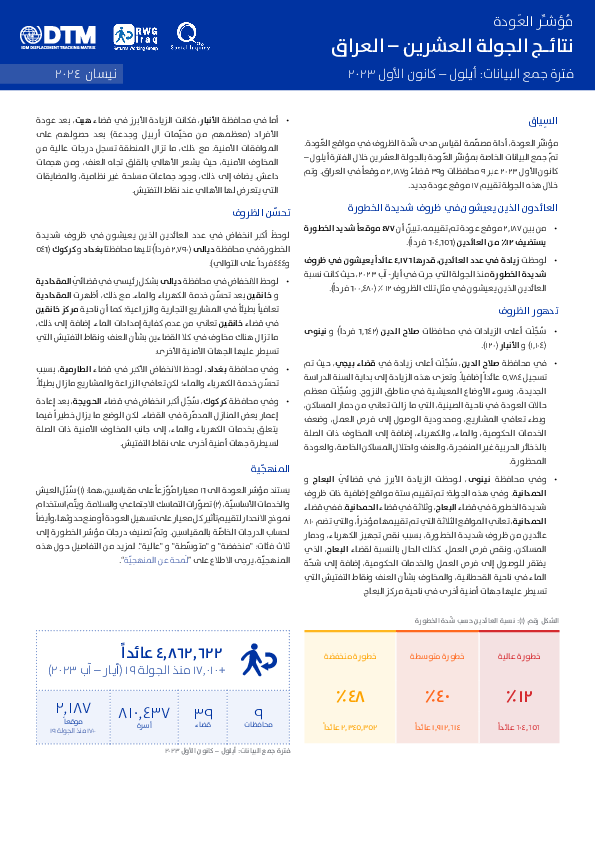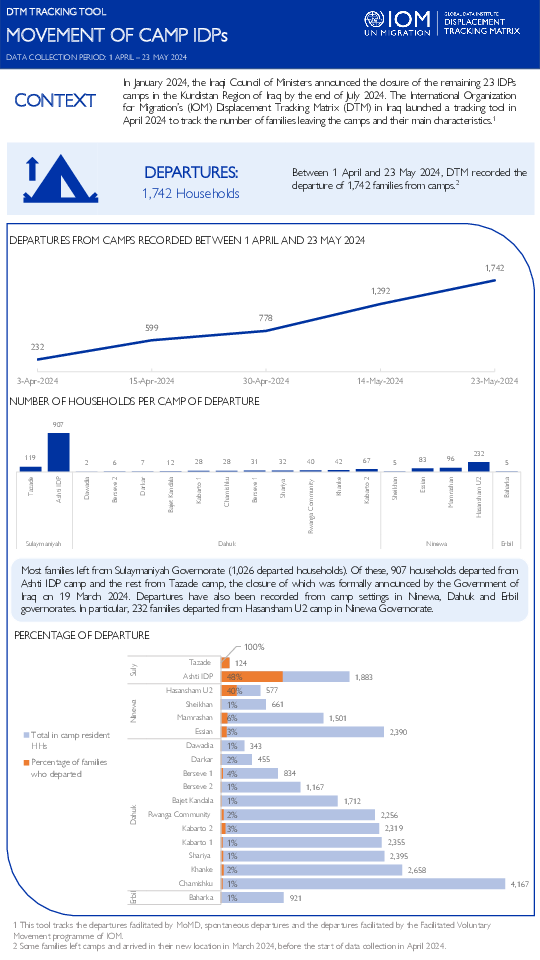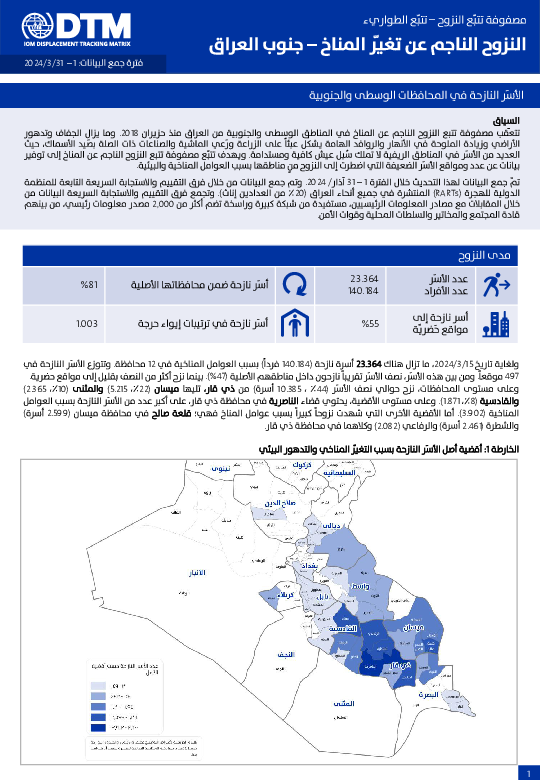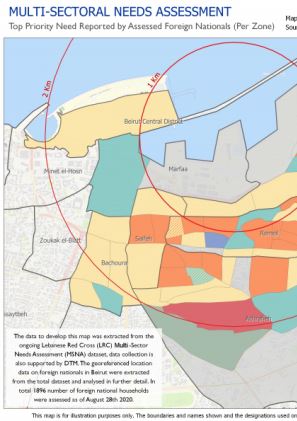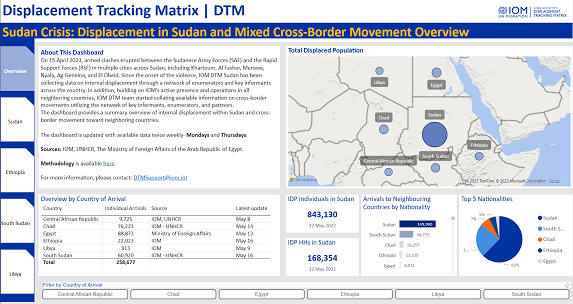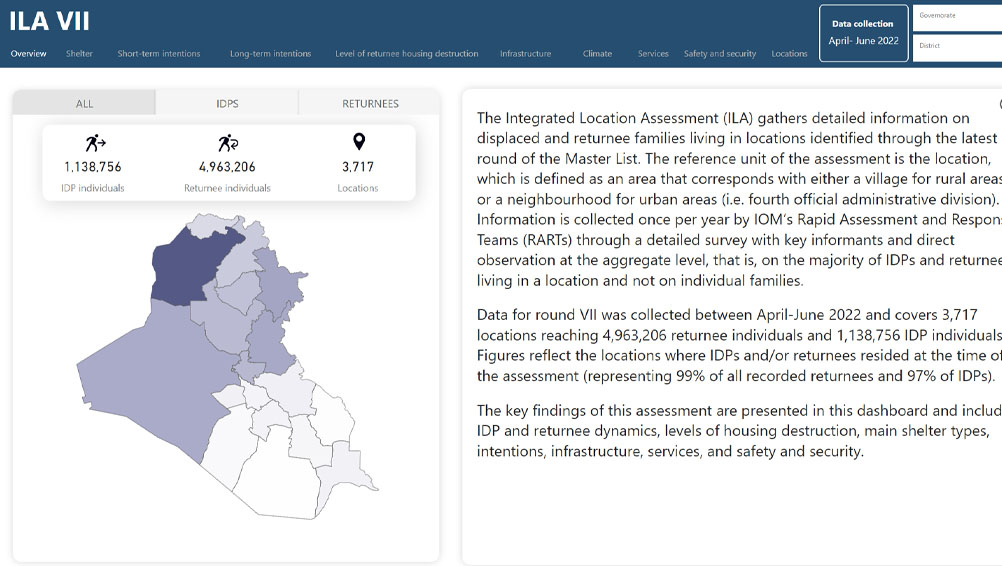-
Countries
-
Data and Analysis
-
Special Focus
-
Crisis Responses
Middle East and North Africa
DTM Middle East and North Africa
DTM Operations in the region
- Active DTM operation
- Past DTM operation
Lebanon - Mobility Snapshot - Round 40 - 25-07-2024
Since October 8 there has been an increase in cross-border incidents between Israel and Lebanon, resulting in the displacement of people both within the South and elsewhere within the country.
DTM Sudan Mobility Update (04)
Overview: This report provides an overview of the total population of internally displaced persons (IDPs) in Sudan, including those displaced both before and after the onset of conflict on 15 April 2023.
Jul 23 2024
DTM Sudan Mobility Update (04)
Yemen — Rapid Displacement Tracking Update (14 - 20 July 2024)
IOM Yemen DTM’s Rapid Displacement Tracking (RDT) tool collects data on estimated numbers of households forced to flee on a daily basis from their locations of origin or displacement, allowing for regular reporting of new displacements in terms of estimated numbers,
Sudan Mobility Overview (1)
The Sudan Mobility Overview provides an in-depth analysis of displacement and mobility in Sudan between 01 May - 03 July 2024. This bi-monthly report summarizes displacement pathways, movement intentions, and humanitarian needs of IDPs in Sudan.
Jul 16 2024
Sudan Mobility Overview (1)
Yemen - Flow Monitoring Registry | Non-Yemeni Migrant Arrivals and Yemeni Migrant Returnees in June 2024
OVERVIEW: The Flow Monitoring Registry (FMR) of the IOM Yemen Displacement Tracking Matrix (DTM) monitors the arrival of migrants along Yemen’s southern coastal border and the return of Yemeni nationals along its northern border with the Kingdom of Saudi Arabia
اليمن - تسجيل مراقبة التدفق | المهاجرون غير اليمنيين واليمنيون العائدون من المملكة العربية السعودية في يونيو 2024
نظرة عامة: يراقب سجل مراقبة التدفق للهجرة، وصول المهاجرين على طول الحدود الساحلية الجنوبية لليمن وإعادة المواطنين اليمنيين إلى وطنهم على طول حدودها الشما
Yemen — Rapid Displacement Tracking Update (07 - 13 July 2024)
IOM Yemen DTM’s Rapid Displacement Tracking (RDT) tool collects data on estimated numbers of households forced to flee on a daily basis from their locations of origin or displacement, allowing for regular reporting of new displacements in terms of estimated numbers,
Profile of Migrants from Pakistan in Libya (July 2024)
This profile provides information on the most recent migration dynamics between Pakistan and Libya as well as the sociodemographic characteristics of Pakistani migrants and information on the routes they travelled to reach Libya.
Lebanon - Mobility Snapshot - Round 39 - 11-07-2024
Since October 8 there has been an increase in cross-border incidents between Israel and Lebanon, resulting in the displacement of people both within the South and elsewhere within the country.
DTM Sudan : Active Methodological Components 2024
The Displacement Tracking Matrix (DTM) is a system to track and monitor displacement and population mobility. DTM Sudan collects primary data, with a focus on providing the best estimates to support the wider humanitarian community and inform humanitarian programming.
Profile of Migrants from Bangladesh in Libya (July 2024)
This profile provides information on the most recent migration dynamics between Bangladesh and Libya as well as the sociodemographic characteristics of Bangladeshi migrants and information on the routes they travelled to reach Libya.
Profile of Migrants from Niger in Libya (June 2024)
This profile provides information on the most recent migration dynamics between Niger and Libya as well as the sociodemographic characteristics and vulnerabilities of Nigerien migrants in Libya, including their level of access to healthcare and employment conditions.
مؤشر العودة: نتائج الجولة العشرين - العراق (سبتمبر - ديسمبر 2023)
he Return Index report (Arabic translation) provides triannual updates on the severity of conditions in locations of return using 16 indicators across two domains: (1) livelihoods and basic services, and (2) social cohesion and safety perceptions.
Iraq — Emergency Tracking - Movement of Camp IDPs (April – 20 May 2024)
In January 2024, the Iraqi Council of Ministers announced the closure of the remaining 23 IDPs camps in the Kurdistan Region of Iraq by the end of July 2024.
تتبع حالات الطوارئ: النزوح الناجم عن المناخ - وسط وجنوب العراق (1-31 مارس 2024)
Climate-Induced Displacement report (Arabic translation) provides quarterly updates on the number and locations of vulnerable families forced to be displaced due to climatic and environmental factors.
تقرير القائمة الرئيسية للجولة 131 ( أيلول - كانون الأول 2023
The Master List report (Arabic translation) provides triannual updates on the number of IDPs and returnees in Iraq, recent movements and overall trends, shelter type, IDP areas of origin and areas of no return.
Iraq — Progress Toward Durable Solutions In Iraq: Sinjar District (June 2024)
This factsheet on Sinjar District is an extension of the original pilot project in Ninewa Governorate aimed at assessing progress towards durable solutions to displacement for internally displaced persons (IDPs) and returnees in the governorates with the largest shares
Profile of Migrant Construction Workers in Libya (June 2024)
This document showcases the profile of construction migrant workers in Libya surveyed by DTM Libya in 2023.
Yemen — Rapid Displacement Tracking Update (30 June - 06 July 2024)
IOM Yemen DTM’s Rapid Displacement Tracking (RDT) tool collects data on estimated numbers of households forced to flee on a daily basis from their locations of origin or displacement, allowing for regular reporting of new displacements in terms of estimated numbers,
Profile of Migrant Agricultural Workers in Libya (June 2024)
This document showcases the profile of agricultural migrant workers in Libya surveyed by DTM Libya in 2023.
DTM Sudan Focused Flash Alert North Darfur (Update 003)
Since 01 April 2024, DTM monitored numerous clashes across Al Fasher and other localities in North Darfur state that triggered widespread displacement.
Libya — Maritime Update Libyan Coast (23-29 June 2024)
This fact sheet provides a bi-weekly update on migration-related events off the Libyan coast. During the reporting period, 226 migrants were intercepted and returned to Libya during the reporting period.
Navigating the Effects of Displacement: Yemen
Following the release of the first edition of PROGRESS 2023 report, the Displacement Tracking Matrix (DTM) carried out focus group discussions to understand the nuances of the effects of displacement from the perspectives
Jul 01 2024
Navigating the Effects of Displacement: Yemen
Yemen — Rapid Displacement Tracking Update (23- 29 June 2024)
IOM Yemen DTM’s Rapid Displacement Tracking (RDT) tool collects data on estimated numbers of households forced to flee on a daily basis from their locations of origin or displacement, allowing for regular reporting of new displacements in terms of estimated numbers,
Pagination
Dataset Sudan - Countrywide Mobility Update 4 (Bi-Weekly)
Jul 26 2024
<ul><li>An estimated total of 10,703,327 IDPs&nbsp;were displaced to 8,712 locations, in 183 localities, across&nbsp;all 18 states in Sudan.</li><li>An estimated 7,903,880 individuals were displaced internally within Sudan since 15 April 2023.&nbsp;</li>…
Lebanon - IDP Tracking Dataset - ROUND 39 - 11-07-2024
Jul 11 2024
<p>Since October 8 there has been an increase in cross-border incidents between Israel and Lebanon, resulting in the displacement of people both within the South and elsewhere within the country. Since October 10, the Displacement Tracking Matrix (DTM) has been conducting the daily monitoring…
Yemen — Rapid Displacement Tracking Dataset (14 - 20 July 2024)
Jul 21 2024
<p>From 1 January to 20 July 2024, IOM Yemen DTM tracked 1,821 households (HH) (10,926 Individuals) who experienced displacement at least once.</p><p>Between 14 and 20 July 2024, IOM Yemen DTM tracked 57 households (342 individuals) displaced at least once. The majority of people…
Sudan - Countrywide Mobility Overview 1(Bi-Monthly)
Jul 19 2024
<ul><li>DTM Sudan estimates that&nbsp;<strong>10,594,576</strong> individuals (<strong>2,129,632</strong> households)&nbsp;are internally displaced in Sudan, as of 03 July 2024.</li><li>An estimated <strong>7,794,480</strong>…
DTM Yemen - Flow Monitoring Datasets - June 2024
Jul 15 2024
<p>In June 2024, the IOM Yemen DTM tracked 1,820 migrants entering Yemen, an eight per cent increase from the total figure reported in the previous month (1,685 migrants). All migrants (100%) left from Bari Region in Somalia.</p><p>Among the total migrants recorded, 17 per cent…
Yemen — Rapid Displacement Tracking Dataset (07 - 13 July 2024)
Jul 14 2024
<p>From 1 January to 13 July 2024, IOM Yemen DTM tracked 1,745 households (HH) (10,470 Individuals) who experienced displacement at least once.</p><p>Between 7 and 13 July 2024, IOM Yemen DTM tracked 29 households (174 individuals) displaced at least once. The majority of people…
Lebanon - IDP Tracking Dataset - ROUND 38 - 27-06-2024
Jun 27 2024
<p>Since October 8 there has been an increase in cross-border incidents between Israel and Lebanon, resulting in the displacement of people both within the South and elsewhere within the country. Since October 10, the Displacement Tracking Matrix (DTM) has been conducting the daily monitoring…
Yemen — Rapid Displacement Tracking Dataset (30 June - 06 July 2024)
Jul 08 2024
<p>From 1 January to 6 July 2024, IOM Yemen DTM tracked 1,688 households (HH) (10,128 Individuals) who experienced displacement at least once.</p><p>Between 30 June and 6 July 2024, IOM Yemen DTM tracked 44 households (264 individuals) displaced at least once. The majority of…
Yemen — Rapid Displacement Tracking Dataset (23 - 29 June 2024)
Jul 01 2024
<p>From 1 January to 29 June 2024, IOM Yemen DTM tracked 1,622 households (HH) (9,732 Individuals) who experienced displacement at least once.</p><p>Between 23 and 29 June 2024, IOM Yemen DTM tracked 43 households (258 individuals) displaced at least once. The majority of people…
Libya - Migrants Baseline Assessment Round 52
Jun 28 2024
<p>Libya Migrants baseline assessment and flow monitoring Round 52</p>
Sudan - Countrywide Mobility Update 3 (Bi-Weekly)
Jun 26 2024
<p>Sudan hosts an estimated <strong>10,540,215</strong> internally displaced persons (IDPs) as of <strong>16 June 2024</strong>, including those displaced both before and after the outbreak of conflict between the Sudanese Armed Forces (SAF) and Rapid Support Forces (…
Yemen — Rapid Displacement Tracking Dataset (16 - 22 June 2024)
Jun 24 2024
<p>From 1 January to 22 June 2024, IOM Yemen DTM tracked 1,564 households (HH) (9,384 Individuals) who experienced displacement at least once.</p><p>Between 16 and 22 June 2024, IOM Yemen DTM tracked 7 households (42 individuals) displaced at least once. The majority of people…
Yemen — Rapid Displacement Tracking Dataset (09 - 15 June 2024)
Jun 24 2024
<p>From 1 January to 15 June 2024, IOM Yemen DTM tracked 1,557 households (HH) (9,342 Individuals) who experienced displacement at least once.</p><p>Between 9 and 15 June 2024, IOM Yemen DTM tracked 15 households (90 individuals) displaced at least once. The majority of people…
Lebanon - IDP Tracking Dataset - ROUND 37 - 13-06-2024
Jun 13 2024
<p>Since October 8 there has been an increase in cross-border incidents between Israel and Lebanon, resulting in the displacement of people both within the South and elsewhere within the country. Since October 10, the Displacement Tracking Matrix (DTM) has been conducting the daily monitoring…
DTM Yemen - Flow Monitoring Datasets - May 2024
Jun 20 2024
<p>In May 2024, the IOM Yemen DTM reported 1,685 migrants entering Yemen, a 14 per cent increase from the total figure reported in the previous month (1,479 migrants). Most migrants (90%) left from Bari Region in Somalia (1,510), while the remaining ten per cent left from Obock, Djibouti.…
Sudan - Countrywide Mobility Update 2 (Bi-Weekly)
Jun 18 2024
<ul><li>An estimated total of 10,095,054 IDPs&nbsp;were displaced across 8,239 locations, in 183 localities in all 18 states in Sudan.</li><li>An estimated 7,262,187 individuals were displaced internally within Sudan since 15 April 2023.&nbsp;</li><li>An…
Lebanon - IDP Tracking Dataset - ROUND 36 - 30-05-2024
May 30 2024
<p>Since October 8 there has been an increase in cross-border incidents between Israel and Lebanon, resulting in the displacement of people both within the South and elsewhere within the country. Since October 10, the Displacement Tracking Matrix (DTM) has been conducting the daily monitoring…
Yemen — Rapid Displacement Tracking Dataset (02 - 08 June 2024)
Jun 10 2024
<p>From 1 January to 8 June 2024, IOM Yemen DTM tracked 1,530 households (HH) (9,180 Individuals) who experienced displacement at least once.</p><p>Between 2 and 8 June 2024, IOM Yemen DTM tracked 38 households (228 individuals) displaced at least once. The majority of people…
Yemen — Rapid Displacement Tracking Dataset (26 May - 01 June 2024)
Jun 03 2024
<p>From 1 January to 1 June 2024, IOM Yemen DTM tracked 1,465 households (HH) (8,790 Individuals) who experienced displacement at least once.</p><p>Between 26 May and 1 June 2024, IOM Yemen DTM tracked 57 households (342 individuals) displaced at least once. The majority of people…
Lebanon - IDP Tracking Dataset - ROUND 35 - 16-05-2024
May 30 2024
<p>Since October 8 there has been an increase in cross-border incidents between Israel and Lebanon, resulting in the displacement of people both within the South and elsewhere within the country. Since October 10, the Displacement Tracking Matrix (DTM) has been conducting the daily monitoring…
Pagination
Lebanon — Foreign Nationals MSNA Analysis: Type of Assistance Received by Foreign Nationals (September 2020)
On 4th August 2020, a large explosion occurred at the port of Beirut, Lebanon that left more than 6,500 individuals injured and caused at least 180 deaths. To assess the impact of the explosion and the arising needs and vulnerabilities, the Lebanese Red Cross (LRC), in coordination with the Office for the Coordination of Humanitarian Affairs (OCHA), have conducted large multi-sectoral needs assessments (MSNA) across 11,008 households. To support these efforts as well as draw attention to the gap on the needs and vulnerabilities of foreign nationals that were affected by the explosion, IOM has undertaken a secondary data review of LRC’s data. This map uses the data of 1,896 foreign national households with migrant workers in Beirut to provide an overview on the type of assistance received by foreign nationals. For information on the Foreign Nationals Multi-Sector Needs Assessment Analysis Report, please visit: https://migration.iom.int/node/9637
Lebanon —Foreign Nationals MSNA Analysis: Priority Needs Reported by Foreign Nationals (September 2020)
On 4th August 2020, a large explosion occurred at the port of Beirut, Lebanon that left more than 6,500 individuals injured and caused at least 180 deaths. To assess the impact of the explosion and the arising needs and vulnerabilities, the Lebanese Red Cross (LRC), in coordination with the Office for the Coordination of Humanitarian Affairs (OCHA), have conducted large multi-sectoral needs assessments (MSNA) across 11,008 households. To support these efforts as well as draw attention to the gap on the needs and vulnerabilities of foreign nationals that were affected by the explosion, IOM has undertaken a secondary data review of LRC’s data. This map uses the data of 1,896 foreign national households with migrant workers in Beirut to provide an overview on the priority needs.For information on the Foreign Nationals Multi-Sector Needs Assessment Analysis Report, please visit: https://migration.iom.int/node/9637
Lebanon — Foreign Nationals MSNA Analysis: Population Overview (September 2020)
On 4th August 2020, a large explosion occurred at the port of Beirut, Lebanon that left more than 6,500 individuals injured and caused at least 180 deaths. To assess the impact of the explosion and the arising needs and vulnerabilities, the Lebanese Red Cross (LRC), in coordination with the Office for the Coordination of Humanitarian Affairs (OCHA), have conducted large multi-sectoral needs assessments (MSNA) across 11,008 households. To support these efforts as well as draw attention to the gap on the needs and vulnerabilities of foreign nationals that were affected by the explosion, IOM has undertaken a secondary data review of LRC’s data. This map uses the data of 1,896 foreign national households with migrant workers in Beirut to provide an overview on the nationalities of foreign nationals.For information on the Foreign Nationals Multi-Sector Needs Assessment Analysis Report, please visit: https://migration.iom.int/node/9637
Lebanon — Foreign Nationals MSNA Analysis: Post-Incident Household Assistance (September 2020)
On 4th August 2020, a large explosion occurred at the port of Beirut, Lebanon that left more than 6,500 individuals injured and caused at least 180 deaths. To assess the impact of the explosion and the arising needs and vulnerabilities, the Lebanese Red Cross (LRC), in coordination with the Office for the Coordination of Humanitarian Affairs (OCHA), have conducted large multi-sectoral needs assessments (MSNA) across 11,008 households. To support these efforts as well as draw attention to the gap on the needs and vulnerabilities of foreign nationals that were affected by the explosion, IOM has undertaken a secondary data review of LRC’s data. This map uses the data of 1,896 foreign national households with migrant workers in Beirut to provide an overview on the post-incident household assistance. For information on the Foreign Nationals Multi-Sector Needs Assessment Analysis Report, please visit: https://migration.iom.int/node/9637












